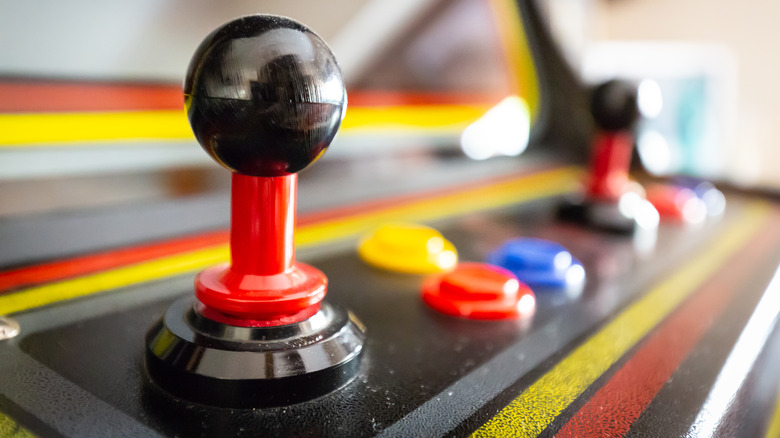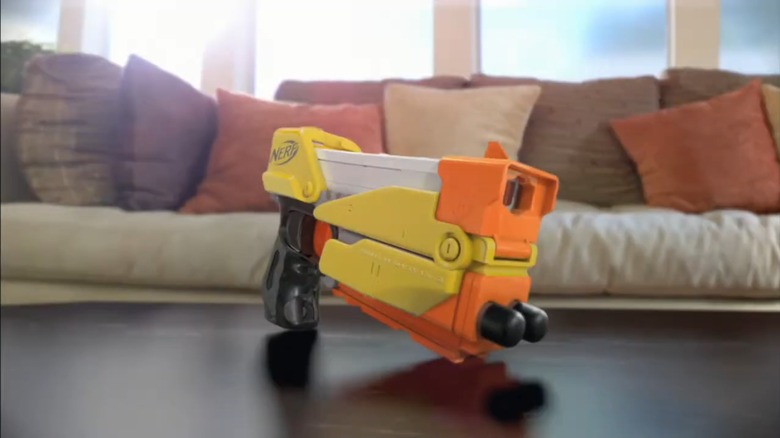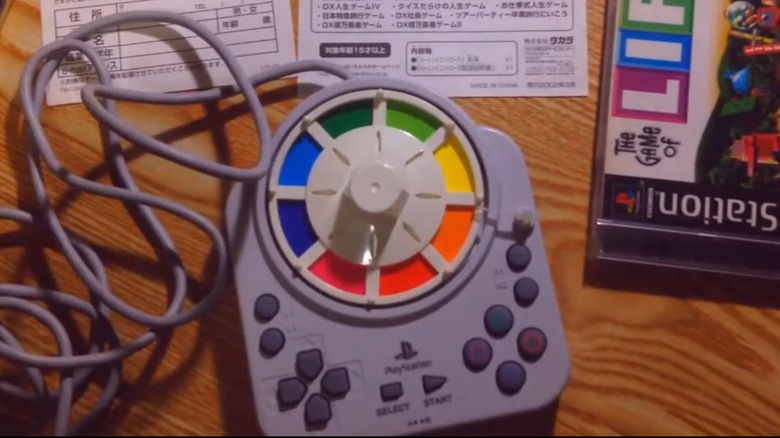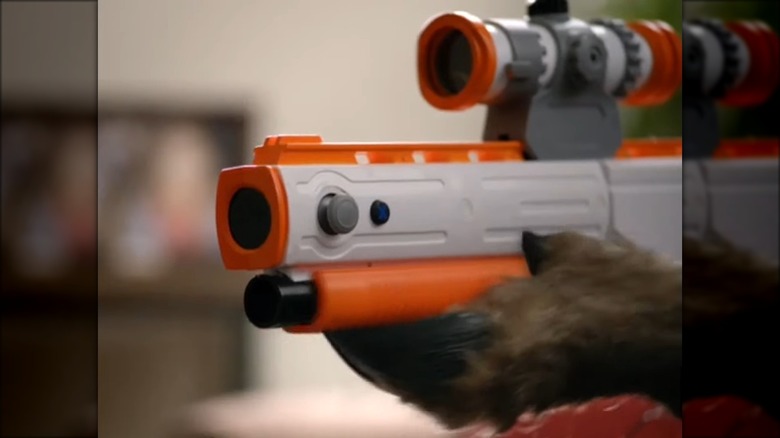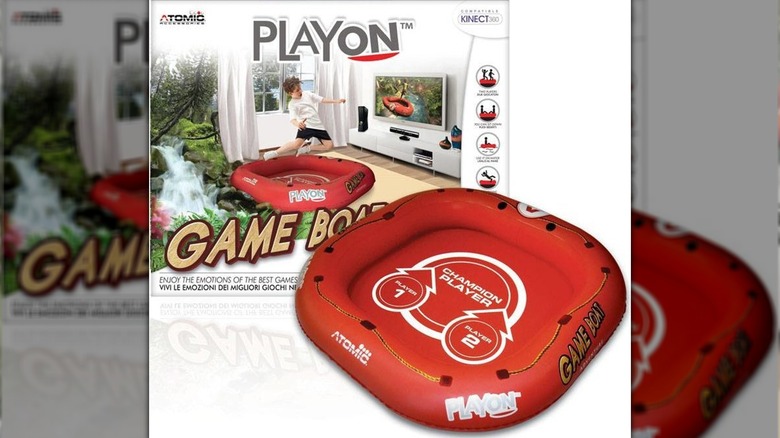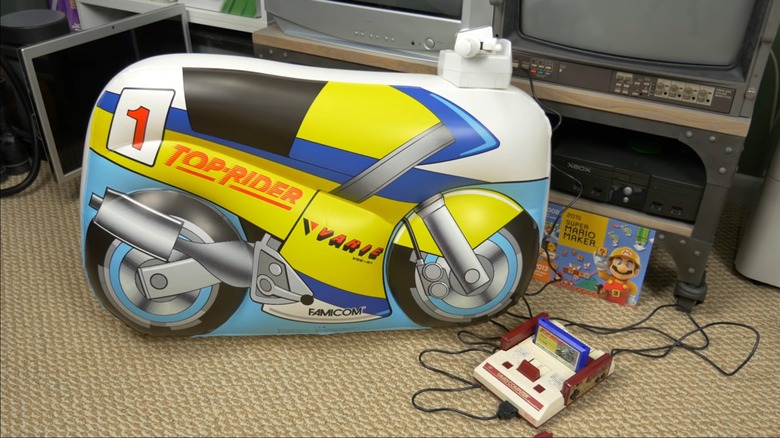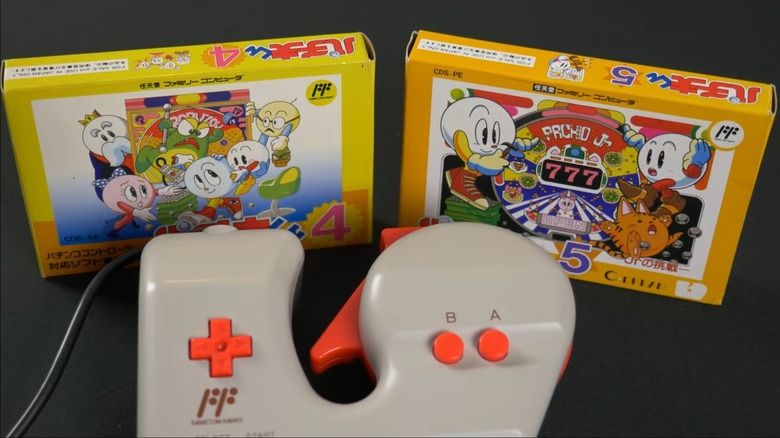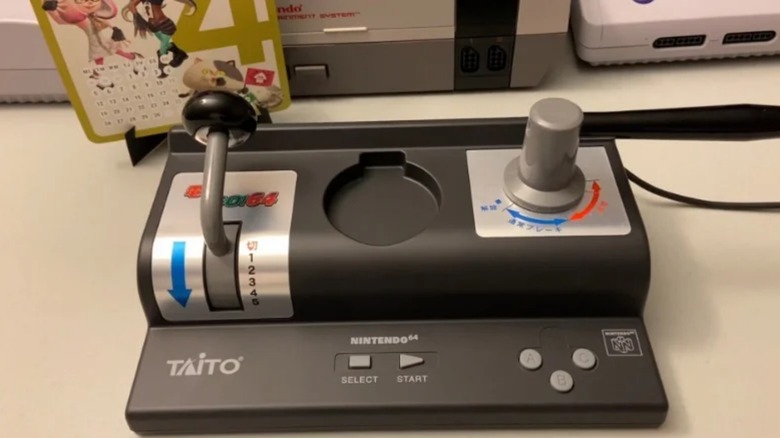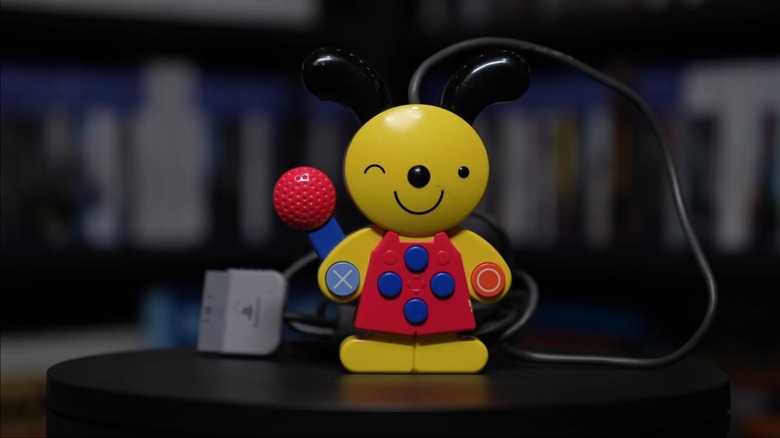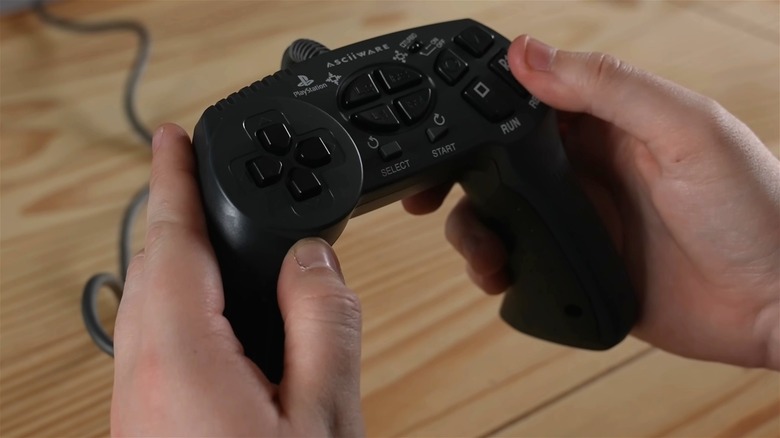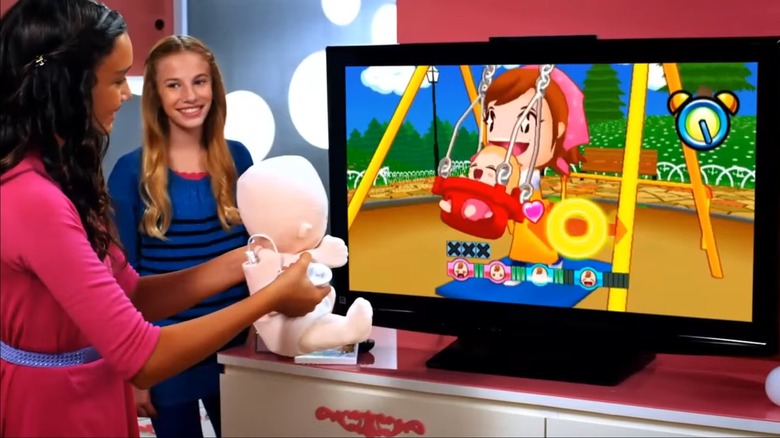10 Obscure Gaming Accessories That Broke The Mold
As an interactive medium, video games require controllers. Some companies have experimented with alternatives to controllers, but more often than not manufacturers return to the tried and true strategy of placing a plastic gizmo filled with buttons and analog sticks between players' hands. However, just because controllers are the de facto method of controlling games doesn't mean companies can't have some fun with the design.
The world of video games is full of off-the-wall controllers, many of which have become famous — or infamous. Most gamers probably know about the Nintendo Power Glove and why it was so bad or that Capcom and Microsoft once manufactured a behemoth of a controller that simulated commanding a walking tank. However, did you know Nerf once produced a controller for the Wii? Or that Nintendo's first foray into motion controls never left Japan?
Probably not, and there's plenty more where that comes from. With that in mind, let's look at some of the most obscure controllers ever sold to gamers, shall we?
Switch Shot EX-3
The Nintendo Wii marked the beginning of Nintendo's mission to prioritize fun gameplay over graphics. Well, that and to add motion controls to as much as possible. The Wii was plagued with far too many titles where controls were reduced to wiggling the Wii remote around like a pretend lightsaber, but the console also let developers create numerous light gun games. Most of these titles consisted of pointing the Wii remote at the TV, but some developers went a step further.
In the late 2000s, Hasbro teamed up with EA to develop two video games based on its then-current iterations of longrunning Nerf dart blasters, "Nerf N-Strike" and "Nerf N-Strike Elite." Both titles were rail shooters and glorified interactive commercials, but instead of just making players point a Wii remote at a TV screen, the developers wanted to let players feel like they were using a real Nerf gun. How did they do this? By making them use a real Nerf gun to play the game.
Each copy of "Nerf N-Strike" and "Nerf N-Strike Elite" included a Switch Shot EX-3, which was a standard plunger-powered Nerf gun with three darts. Unlike other Nerfs, however, the plunger section could be separated from the trigger and replaced by a Wii remote. This feature allowed audiences to play the games while enjoying all the ergonomics and heft of a real toy gun, trigger and all. Granted, other third-party manufacturers sold accessories that gave Wii remotes trigger grips for light gun games, but only the Switch Shot EX-3 could be used for both Wii games and an actual Nerf war.
Takara Roulette Controller
Many board games have been converted into video games. However, most if not all of these digital translations utilize the standard control schemes of mouse and keyboard or controller, possibly because most board games use dice. Japanese designers thought it would be a great idea to give a dice-free game a unique control scheme that required an equally unique controller.
When "The Game of Life" was ported to the PlayStation, the American version used the buttons already available on the controller, and like most games, this port primarily revolved around the X button. Press X to make selections, press X to confirm choices, and, most importantly, hold X to spin the digital spinner that determines how many spaces you move. The Japanese version of "The Game of Life" for the PS1 was mostly the same, albeit with more aesthetically pleasing chibi characters instead of giant bobbleheads. However, the biggest difference was the controller.
Dubbed the Takara Roulette Controller, or sometimes the Roulette Controller or Jinsei Controller ("Jinsei" means "Life" in Japanese), this exclusive peripheral looked less like a PS1 controller and more like a square. The bottom portion had all the face buttons of a normal PS1 controller, although the shoulder buttons and triggers had migrated to the front. The controller's most striking feature was the titular roulette that dominated the device's face.
This component only had one use — to be spun. Whenever players wanted to move, they spun the roulette, which controlled the digital spinner. It might seem like a superfluous addition, but it went the extra mile to make the video game feel like an actual session of "The Game of Life."
Top Shot Elite Firearm
Cabela's is a popular outlet for everything camping and fishing, but the store's hunting equipment is what brings in the big bucks — and helps you snag some big bucks during hunting season. Why not attract a new generation of potential customers by having them experience hunting in a safe, digital environment?
Starting in the late 1990s, Cabela's collaborated with Activision to publish a series of hunting games under the name "Cabela's Big Game Hunter." These titles began as point-and-click shooters, and as technology evolved, the games became third-person shooters. Then, in 2009, "Cabela's Big Game Hunter" turned into a light gun experience. The Wii version of "Cabela's Big Game Hunter 2010" included a shotgun-shaped accessory designed to house a Wii remote, but these game peripherals didn't truly hit the mark until "Cabela's Dangerous Hunts 2011," which introduced audiences to the Top Shot Elite Firearm.
This controller was shaped like a kid-friendly hunting rifle and functioned exactly how you think it would. While on a hunt, gamers only needed to aim the fake gun at the screen and squeeze the trigger, but the controller also had analog sticks and buttons for menu navigation. Of course, since the Xbox 360 and PlayStation 3 weren't designed with motion controls in mind, their respective versions of the Top Shot Elite required a USB receiver and light bar.
The Top Shot Elite was compatible with all subsequent "Cabela's Big Game Hunter" titles, as well as spin-offs like "Cabela's Dangerous Hunts," and Activision packaged the light gun with every "Big Game Hunter" sequel. However, titles such as "Cabela's Big Game Hunter: Hunting Party" included an alternative shotgun-like peripheral instead.
Play On Game Boat
Microsoft's Kinect was ultimately a failed experiment. Even though the peripheral was supposed to turn gamers into their own controllers, most Kinect games struggled to register player movements or provide fun gameplay. On the bright side, Kinect didn't require any additional accessories — just set up the camera and cross your fingers. Some third-party manufacturers didn't get the memo.
One of the first titles released for the Kinect was "Kinect Adventures!" The game sold fairly well — mostly because a copy was included with every Kinect — and centered around minigame challenges such as smashing blocks with balls and whitewater rafting. To help gamers get into the spirit of rafting, the unofficial peripheral company Atomic Accessories created the Play On Game Boat.
This accessory's name said it all, as the Game Boat was an inflatable boat. That's it. The item was pure gimmick since it didn't offer any advantages in "Kinect Adventures!" and was designed with one minigame in mind. The Game Boat's only redeeming quality was that it could probably float on water — with an emphasis on the word "probably." We're not sure if anyone ever tested this feature, but even if they did, we wouldn't be surprised if they concluded that an inflatable game accessory designed for living rooms didn't work as well as an actual raft designed for water.
Inflatable Top Rider Bike
While Nintendo's most recent console, the Switch, sports controllers that function like traditional game peripherals, Nintendo's obsession with motion controls bled into these devices via built-in accelerometers and gyro functionality. However, Nintendo actually started testing the motion control waters over two decades before the Wii made them a signature feature. With a glorified balloon, no less.
In 1988, Nintendo released the game "Top Rider" exclusively for the Famicom which meant the game wasn't ported to Western markets. Unlike Famicom's other notable motorcycle game, "Excitebike," "Top Rider" utilized a unique control scheme consisting of toy motorcycle handlebars. To control the on-screen bike, players had to rev and turn the handlebars and occasionally squeeze the brake, just like a real motorcycle. Still, that was only half the fun.
The true magic of "Top Rider" lay in how gamers mounted the proprietary controller. Instead of placing it on a table, the peripheral was meant to be slotted onto an inflatable motorbike that also came with the game. The result let kids feel as though they were actually riding a motorcycle. Heck, if they wanted to pop a wheelie in "Top Rider," they only had to do so in real life by leaning back and lifting up the bike balloon. This control scheme never caught on, but we still occasionally see racing wheels in circulation, so the concept isn't completely dead.
Coconuts Japan Pachinko Controller
In 1987, Coconuts Japan released the first in a series of pachinko games for the Famicom. The games, colloquially known as Pachio-kun, starred the company's mascot, an anthropomorphic (and vaguely Pac-Man-esque) pachinko ball of the same name. The first entries used the standard Famicom controllers, but in 1991, Coconuts Japan released a unique Famicom add-on modeled after real pachinko machines.
The Coconuts Japan Pachinko Controller (which is spelled "Pachinko Controler" on the box) was a U-shaped, fully functional Famicom controller with an additional spring-loaded wheel. This inclusion functioned the same as a real pachinko machine's wheel, as by twisting it, gamers could alter the speed balls launched in the game. It might not sound like much, but truth be told, turning wheels to alter ball launch speed is really all there is to pachinko games in general.
Since the Coconuts Japan Pachinko Controller was released late in the Pachio-kun franchise's life, and because Coconuts Japan cornered the market on Famicom pachinko games, the device's pachinko wheel was only compatible with a handful of titles. On the bright side, however, the Pachinko Controller's buttons were fully functional, so the device could also fill the role of a regular Famicom controller if necessary.
Densha de Go! Train Controller
In Japan, the transit system is so highly respected that if a train runs five minutes late, all passengers receive a certificate that explains to employers why the holders didn't get to work on time. Is it any wonder why the Japanese game developer Taito tries to make their train simulators feel as authentic as possible?
"Densha de Go!" is a long-running series of titles that puts players in the shoes of a train conductor, and the franchise's main hook is its proprietary controllers created for a variety of platforms. Instead of having players control a train with an analog stick and face buttons, Taito developed a unique accessory that mimics the control panel of an actual Japanese train. The left handle dictates speed, while the right controls the brakes. It's a simple control scheme, but the game's challenge lies in making all the stops on time, which occasionally comes down to the millisecond.
Since the "Densha de Go!" controller reflects real-life train panels, Taito recycled the design for almost every subsequent entry. The orignal PlayStation, Nintendo 64, and plug-and-play editions all shared the same shape and controls, although the Nintendo Switch version consolidated speed and braking into the left lever. This deviation rendered the right handle as superfluous as it was immobile. Also, for whatever reason, The Switch entry's controller did away with the original peripheral's iconic divot meant to hold pocket watches. It's unrealistic to assume any gamer owned one, but the divot used to help conductors stay on time, so it was included anyway.
Kids Station Controllers
While a video game's content determines its target demographic, the control scheme is also a deciding factor. Games with complex controls or mechanics generally cater to older audiences, whereas younger players usually require simpler controls. So what's the best way to program the controls of a game meant for toddlers?
Kids Station is one of Japan's premier children-oriented TV stations, and it used to produce licensed games aimed at very young children. While toddlers could play these titles with a standard PlayStation 1 controller, the games were designed for Kids Station's proprietary controller, which was essentially just the PS1's main face buttons inflated to insane proportions. No D-pad or shoulder buttons, just the X, O, Square, and Triangle buttons. Despite lacking most of a PS1's inputs, the Kids Station controller was compatible with all but a few of the company's titles.
While most Kids Station games worked with the Kids Station oversized buttons, a few were designed for the company's other controller, Hanamaru-kun. This accessory was named after the main character of the show "Guru Guru Town Hanamaru-kun," Hanamaru, and sported a D-pad, an X and O button, as well as a microphone, all packed in with "Guru Guru Town Hanamaru-kun" game.
Like other Kids Station titles, this simple controller reflected a simple gameplay loop, and Kids Station recycled the design for similar titles starring Hello Kitty, Mickey Mouse, and Winnie the Pooh. Each exterior looked different, but they all shared the same innards and functions. Plus, each controller came with their own game!
BioHazard Dedicated Controller
"Resident Evil" didn't invent the survival horror genre, but it definitely popularized it. The game's setting, difficulty, and atmosphere drew in audiences and left a lasting impression despite the nonintuitive controls. Instead of fixing the control scheme, Capcom decided it was easier to shift around controller buttons.
ASCII's Biohazard Dedicated Controller looked sort of like a standard PlayStation 1 controller — albeit black — until you got a good look at its button layout. The D-pad was in the right place, and the X, O, and Triangle buttons were mostly unchanged if at an angle, but the Square button had been replaced by R1, which aimed weapons. Where is the actual Square button? ASCII and Capcom transfigured it into a trigger for the right prong, which was now shaped like a gun handle. Meanwhile, the left handle was shaped like a knife grip.
It's hard to think of a more fitting design choice for a game where you rely on firearms to kill zombies. As for the other shoulder buttons, they all migrated to the controller's face, but unlike the PS1 original's control scheme, these buttons now opened the map and inventory screens. The U.S. version of the controller, this time called the Resident Evil Pad, even included a bonus turbo toggle.
Babysitting Mama Baby Plush
The "Cooking Mama" games began as a minigame collection on the Nintendo DS and soon arrived on the Wii. The franchise also branched into spin-offs that focused on different activities commonly associated with motherhood. Regardless of the subject matter, each Wii entry invariably required players to waggle around the Wii remote, but when it came time to make a game about caring for babies, the developers wanted to do something special.
Like "Cooking Mama" before it, "Babysitting Mama" was a minigame collection revolving around activities related to babies. These included feeding a baby, burping a baby, changing a baby, and rushing to stop dinner from burning because you spent so much time with the baby. Like the "Cooking Mama" games released on the Nintendo Wii, every "Babysitting Mama" activity relied on the Wii remote. However, because Wii remotes were distinctly non-baby-shaped, each copy of "Babysitting Mama" included a large plush doll shaped like an anime infant.
On its own, the doll didn't do anything special, but it had a slot in its back meant to house the Wii remote. Players only had to insert the controller into the plush's back, and they would be ready to play. The accessory made all the movements necessary to play the minigames easier, while the Wii remote's accelerometer did the rest. Also, the controller's speaker would occasionally utter coos and cries to help players judge their performance.
